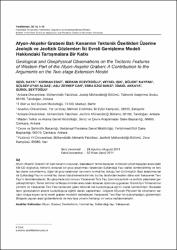| dc.contributor.author | Kaya, Sevil | |
| dc.contributor.author | Esat, Korhan | |
| dc.contributor.author | Ecevitoğlu, Berkan | |
| dc.contributor.author | Kaypak, Bülent | |
| dc.contributor.author | Uyar, Aldaş Gülsev | |
| dc.contributor.author | Seyitoğlu, Gürol | |
| dc.date.accessioned | 2019-10-23T17:56:25Z | |
| dc.date.available | 2019-10-23T17:56:25Z | |
| dc.date.issued | 2014 | |
| dc.identifier.issn | 1301-2894 | |
| dc.identifier.uri | http://www.trdizin.gov.tr/publication/paper/detail/TVRZeU5EYzVPUT09 | |
| dc.identifier.uri | https://hdl.handle.net/11421/22944 | |
| dc.description.abstract | Afyon-Akşehir Grabeni’nin batı kenarını oluşturan, başkalaşım temel kayaçları ile Neojen çökel kayaçları arasındaki KB-GD doğrultulu tektonik dokanak bir grup araştırmacı tarafından Sultandağı Fayı olarak isimlendirilmiş ve ters fay olarak yorumlanmış, diğer bir grup tarafından ise sınırın normal fay olduğu ileri sürülmüştür. Bazı araştırmacılar da Sultandağı Fayı’nı normal fay olarak kabul etmekle birlikte, bu fay tarafından kesilen daha eski Yakasenek Ters Fayı’nı tanımlamışlardır. Bu çalışmada söz konusu Yakasenek Ters Fayı üzerinde jeolojik ve jeofizik çalışmalar gerçekleştirilmiştir. Temel birimler ile Neojen birimler arasındaki dokanak üzerinde uygulanan ‘Sismik Işın Yönlendirme’ yöntemi ile Yakasenek Ters Fayı’na karşılık gelen tektonik hat kuzeydoğuya eğimli olarak belirlenmiştir. Buradaki fayın güneybatının aksine kuzeydoğuya eğimli olarak saptanması, bölgede Miyosen-Pliyosen’de sıkışmanın varlığını ortaya koyan ve iki evreli graben modelini destekleyen Yakasenek Ters Fayı’nın bulunmadığını göstermiştir. Bölgede yapılan arazi gözlemlerinde de ters faya yönelik herhangi bir veriye rastlanmamıştır. | en_US |
| dc.description.abstract | The NW-SE trending tectonic contact between the metamorphic basement and the Neogene sedimentary rocks, located at the western side of the Afyon-Akşehir Graben, is interpreted as a reverse fault and is named as the Sultandağı fault by some researchers. On the contrary, other workers claim that the Sultandağı fault is a normal fault. Some researchers define the Yakasenek reverse fault which is cut by the Sultandağı normal fault. In this study, the geological and geophysical studies have been performed on this tectonic contact. The tectonic contact that corresponds to the Yakasenek reverse fault was determined as a NE-dipping plane using with the 'Seismic Beam Steering' method. The identification of the NE-dipping plane instead of SW-dipping shows that the Yakasenek reverse fault, which is interpreted as a product of the Miocene-Pliocene contraction supporting two-stage graben model, does not exist. There is also no field evidence of reverse faulting in the area. | en_US |
| dc.language.iso | tur | en_US |
| dc.rights | info:eu-repo/semantics/openAccess | en_US |
| dc.subject | Yerbilimleri | en_US |
| dc.subject | Ortak Disiplinler | en_US |
| dc.title | Afyon-Akşehir Grabeni batı kenarının tektonik özellikleri üzerine jeolojik ve jeofizik gözlemler: İki evreli genişleme modeli hakkındaki tartışmalara bir katkı | en_US |
| dc.title.alternative | Geological and geophysical observations on the tectonic features of western part of the Afyon-Akşehir Graben: A contribution to the arguments on the two-stage extension model | en_US |
| dc.type | article | en_US |
| dc.relation.journal | Yerbilimleri | en_US |
| dc.contributor.department | Anadolu Üniversitesi, Yer ve Uzay Bilimleri Enstitüsü | en_US |
| dc.identifier.volume | 35 | en_US |
| dc.identifier.issue | 1 | en_US |
| dc.identifier.startpage | 1 | en_US |
| dc.identifier.endpage | 16 | en_US |
| dc.relation.publicationcategory | Makale - Ulusal Hakemli Dergi - Kurum Öğretim Elemanı | en_US] |


















